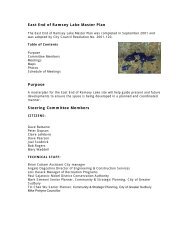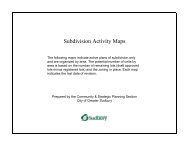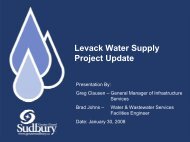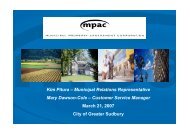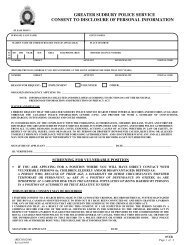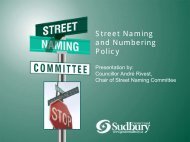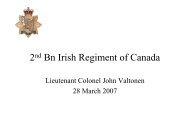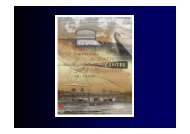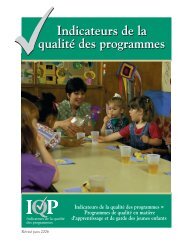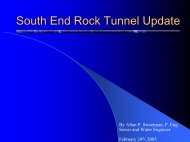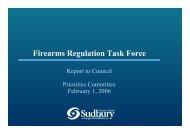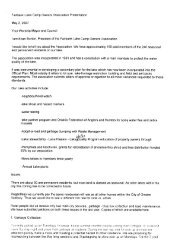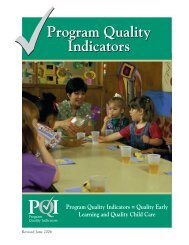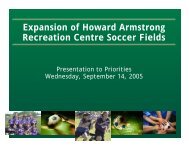City of Greater Sudbury Transportation Study Report
City of Greater Sudbury Transportation Study Report
City of Greater Sudbury Transportation Study Report
You also want an ePaper? Increase the reach of your titles
YUMPU automatically turns print PDFs into web optimized ePapers that Google loves.
4. TRAFFIC FORECASTING MODEL<br />
4.1. Model Overview and Model Limitations<br />
<strong>Greater</strong> <strong>Sudbury</strong>’s traffic forecasting model is comprised <strong>of</strong> four stages, which include Trip<br />
Generation, Trip Distribution, Mode Split and Assignment as shown in Figure 4.1.1. The<br />
components <strong>of</strong> the model are further explained in the following sections. Trip generation<br />
equations were developed to determine the number <strong>of</strong> trips generated by each traffic zone<br />
and the number <strong>of</strong> trips attracted to each traffic zone. The trip generation equations are<br />
based on the findings <strong>of</strong> the household survey. Trips have been categorized into three trip<br />
purposes; home-based work, home-based other and non-home based. Trip distribution<br />
involves the determination <strong>of</strong> the destination choices <strong>of</strong> trip makers (i.e. determines the flow<br />
<strong>of</strong> trips between traffic zones) using the productions and attractions determined from the trip<br />
generation model. A gravity model was used to distribute internal trips (trips having an origin<br />
and destination inside <strong>of</strong> <strong>Greater</strong> <strong>Sudbury</strong>) and the furness bi-proportional method for<br />
external trips (i.e. trips traveling through<br />
<strong>Greater</strong> <strong>Sudbury</strong> or having an origin or<br />
destination outside <strong>of</strong> <strong>Greater</strong> <strong>Sudbury</strong>).<br />
For many municipalities in Canada, this<br />
is the preferred method <strong>of</strong> performing<br />
trip distribution.<br />
Land Use Data<br />
Figure 4.1.1 - Model<br />
Trip Generation<br />
Work, Home-Based Other,<br />
Non-Home Based<br />
External Trips<br />
For the assignment <strong>of</strong> trips to the<br />
network, the equilibrium assignment<br />
technique within TransCAD was used.<br />
TransCAD is a travel demand modeling<br />
s<strong>of</strong>tware that can be used to predict<br />
changes in travel patterns due to<br />
changes in development, demographics,<br />
and transportation choices. This is<br />
discussed further in the next section.<br />
Since the gravity model requires travel<br />
times, which reflect delays caused by<br />
traffic, the model is run iteratively<br />
between the gravity model and trip<br />
assignment.<br />
Road Network<br />
Road Network<br />
Travel Times<br />
Apply Factors<br />
Peak Hour, Occupancy,<br />
Mode Split<br />
Trip Distribution<br />
Work, All Other and Non-<br />
Home Based Combined<br />
Auto Assignment<br />
Apply Growth Rates<br />
The model was validated at the screenline level and is capable <strong>of</strong> producing reasonable<br />
forecasts at the screenline level and at the link level. Link level forecasts were compared to<br />
recent traffic counts to ensure accuracy. However, forecasts from this model cannot<br />
accurately simulate turning movements at intersections, as this model does not take into<br />
account driver behavior, delays at intersections and opposing traffic. For intersection turning<br />
movements, the validated link flows could be used as input into traffic simulation s<strong>of</strong>tware<br />
that can be used to estimate turning movements.<br />
CITY OF GREATER SUDBURY<br />
OFFICIAL PLAN BACKGROUND REPORT<br />
September 2005 Page 38



